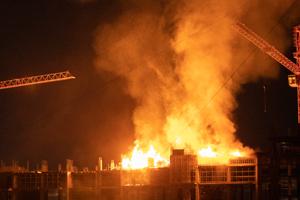Jobsite inspections
Every construction project and jobsite must be inspected for hazards and conditions that could cause injury or illness to workers. Inspections are also an effective way to determine if safety rules are being followed and can help in identifying new training needs.
What does this cover?
- The OSHA rules have inspection requirements for many operations such as demolition work, excavations, steel erection and welding and cutting.
- Specific inspection rules are also necessary for scaffolds, fall protection, electrical equipment, tools, confined spaces, rigging and when workers are exposed to chemicals or using personal protective equipment.
- General work areas must also be inspected for conditions that could cause injuries as a result of slips/trips due to poor housekeeping or improper storage of flammable liquids.
What else do I need to know?
All inspections must be carried out by a competent person who is familiar with the hazards of the work, what should be in place for protection and the safe use of any equipment. While inspections do not have to be documented, unless specified by OSHA rules, it is a good idea to have a system to show your company is looking at these hazards and taking action to correct them.
What about training?
Since inspections must be made by a competent person it is important to make sure they understand both the OSHA rules and your company requirements. A good start is for any person who will be in the role of competent person to take courses such as the OSHA 30 hour or OSHA 510 course. More specific training will be required if they will be the competent person for excavation work, scaffold erection or fall protection.
Where can I get more help?
The Hanover Risk Solutions website has additional information that you can review or use for worker training. Additional resources can also be found on the OSHA website that show where the competent person must be available.
This material is provided for informational purposes only and does not provide any coverage or guarantee loss prevention. The examples in this material are provided as hypothetical and for illustration purposes only. The Hanover Insurance Company and its affiliates and subsidiaries (“The Hanover”) specifically disclaim any warranty or representation that acceptance of any recommendations contained herein will make any premises, or operation safe or in compliance with any law or regulation. By providing this information to you. The Hanover does not assume (and specifically disclaims) any duty, undertaking or responsibility to you. The decision to accept or implement any recommendation(s) or advice contained in this material must be made by you.
LC JAN 2019 12-378
171-1099 (10/14)
Related resources
Jobsite inspections
Every construction project and jobsite must be inspected for hazards and conditions that could cause injury or illness to workers. Inspections are also an effective way to determine if safety rules are being followed and can help in identifying new training needs.
What does this cover?
- The OSHA rules have inspection requirements for many operations such as demolition work, excavations, steel erection and welding and cutting.
- Specific inspection rules are also necessary for scaffolds, fall protection, electrical equipment, tools, confined spaces, rigging and when workers are exposed to chemicals or using personal protective equipment.
- General work areas must also be inspected for conditions that could cause injuries as a result of slips/trips due to poor housekeeping or improper storage of flammable liquids.
What else do I need to know?
All inspections must be carried out by a competent person who is familiar with the hazards of the work, what should be in place for protection and the safe use of any equipment. While inspections do not have to be documented, unless specified by OSHA rules, it is a good idea to have a system to show your company is looking at these hazards and taking action to correct them.
What about training?
Since inspections must be made by a competent person it is important to make sure they understand both the OSHA rules and your company requirements. A good start is for any person who will be in the role of competent person to take courses such as the OSHA 30 hour or OSHA 510 course. More specific training will be required if they will be the competent person for excavation work, scaffold erection or fall protection.
Where can I get more help?
The Hanover Risk Solutions website has additional information that you can review or use for worker training. Additional resources can also be found on the OSHA website that show where the competent person must be available.
This material is provided for informational purposes only and does not provide any coverage or guarantee loss prevention. The examples in this material are provided as hypothetical and for illustration purposes only. The Hanover Insurance Company and its affiliates and subsidiaries (“The Hanover”) specifically disclaim any warranty or representation that acceptance of any recommendations contained herein will make any premises, or operation safe or in compliance with any law or regulation. By providing this information to you. The Hanover does not assume (and specifically disclaims) any duty, undertaking or responsibility to you. The decision to accept or implement any recommendation(s) or advice contained in this material must be made by you.
LC JAN 2019 12-378
171-1099 (10/14)
Related resources
Jobsite inspections
Every construction project and jobsite must be inspected for hazards and conditions that could cause injury or illness to workers. Inspections are also an effective way to determine if safety rules are being followed and can help in identifying new training needs.
What does this cover?
- The OSHA rules have inspection requirements for many operations such as demolition work, excavations, steel erection and welding and cutting.
- Specific inspection rules are also necessary for scaffolds, fall protection, electrical equipment, tools, confined spaces, rigging and when workers are exposed to chemicals or using personal protective equipment.
- General work areas must also be inspected for conditions that could cause injuries as a result of slips/trips due to poor housekeeping or improper storage of flammable liquids.
What else do I need to know?
All inspections must be carried out by a competent person who is familiar with the hazards of the work, what should be in place for protection and the safe use of any equipment. While inspections do not have to be documented, unless specified by OSHA rules, it is a good idea to have a system to show your company is looking at these hazards and taking action to correct them.
What about training?
Since inspections must be made by a competent person it is important to make sure they understand both the OSHA rules and your company requirements. A good start is for any person who will be in the role of competent person to take courses such as the OSHA 30 hour or OSHA 510 course. More specific training will be required if they will be the competent person for excavation work, scaffold erection or fall protection.
Where can I get more help?
The Hanover Risk Solutions website has additional information that you can review or use for worker training. Additional resources can also be found on the OSHA website that show where the competent person must be available.
This material is provided for informational purposes only and does not provide any coverage or guarantee loss prevention. The examples in this material are provided as hypothetical and for illustration purposes only. The Hanover Insurance Company and its affiliates and subsidiaries (“The Hanover”) specifically disclaim any warranty or representation that acceptance of any recommendations contained herein will make any premises, or operation safe or in compliance with any law or regulation. By providing this information to you. The Hanover does not assume (and specifically disclaims) any duty, undertaking or responsibility to you. The decision to accept or implement any recommendation(s) or advice contained in this material must be made by you.
LC JAN 2019 12-378
171-1099 (10/14)
Related resources
Jobsite inspections
Every construction project and jobsite must be inspected for hazards and conditions that could cause injury or illness to workers. Inspections are also an effective way to determine if safety rules are being followed and can help in identifying new training needs.
What does this cover?
- The OSHA rules have inspection requirements for many operations such as demolition work, excavations, steel erection and welding and cutting.
- Specific inspection rules are also necessary for scaffolds, fall protection, electrical equipment, tools, confined spaces, rigging and when workers are exposed to chemicals or using personal protective equipment.
- General work areas must also be inspected for conditions that could cause injuries as a result of slips/trips due to poor housekeeping or improper storage of flammable liquids.
What else do I need to know?
All inspections must be carried out by a competent person who is familiar with the hazards of the work, what should be in place for protection and the safe use of any equipment. While inspections do not have to be documented, unless specified by OSHA rules, it is a good idea to have a system to show your company is looking at these hazards and taking action to correct them.
What about training?
Since inspections must be made by a competent person it is important to make sure they understand both the OSHA rules and your company requirements. A good start is for any person who will be in the role of competent person to take courses such as the OSHA 30 hour or OSHA 510 course. More specific training will be required if they will be the competent person for excavation work, scaffold erection or fall protection.
Where can I get more help?
The Hanover Risk Solutions website has additional information that you can review or use for worker training. Additional resources can also be found on the OSHA website that show where the competent person must be available.
This material is provided for informational purposes only and does not provide any coverage or guarantee loss prevention. The examples in this material are provided as hypothetical and for illustration purposes only. The Hanover Insurance Company and its affiliates and subsidiaries (“The Hanover”) specifically disclaim any warranty or representation that acceptance of any recommendations contained herein will make any premises, or operation safe or in compliance with any law or regulation. By providing this information to you. The Hanover does not assume (and specifically disclaims) any duty, undertaking or responsibility to you. The decision to accept or implement any recommendation(s) or advice contained in this material must be made by you.
LC JAN 2019 12-378
171-1099 (10/14)





